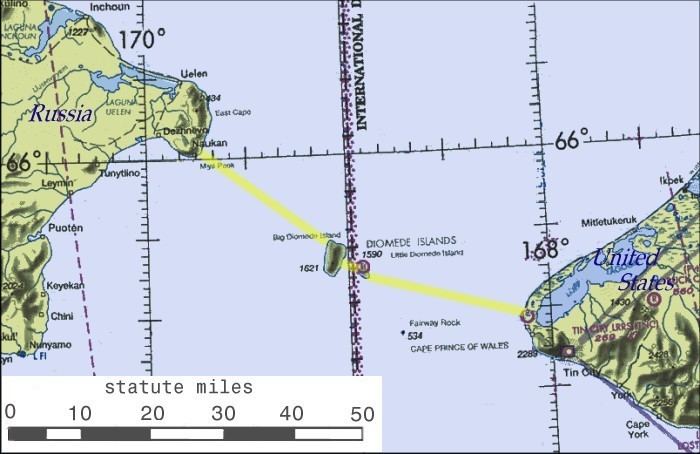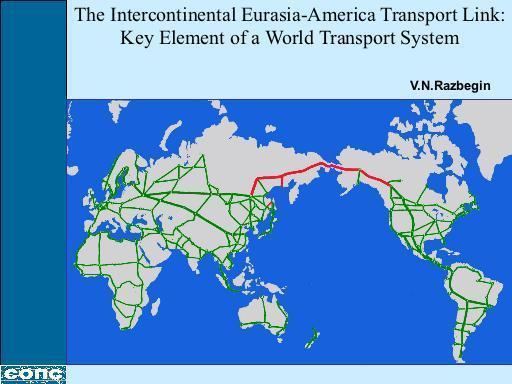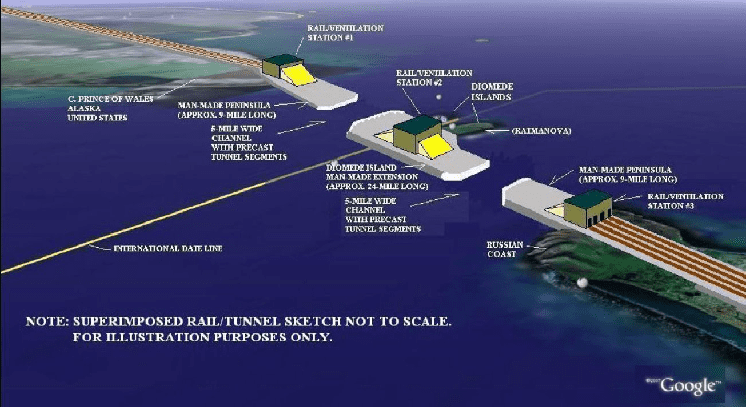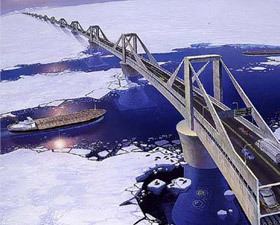 | ||
Similar | ||
Bbc 2006 inside out bering strait crossing
A Bering Strait crossing is a hypothetical bridge and/or tunnel spanning the relatively narrow and shallow Bering Strait between the Chukotka Peninsula in Russia and the Seward Peninsula in the U.S. state of Alaska. The bridge or tunnel would provide a connection linking North America (and potentially South America, see: Darién Gap) with Asia, Africa and Europe.
Contents
- Bbc 2006 inside out bering strait crossing
- History
- Technical problems
- Economic costs
- The TKM World Link
- ChinaRussiaCanadaAmerica railway
- Trans Eurasian Belt Development
- References

With the two Diomede Islands between the peninsulas, the Bering Strait could be spanned by a bridge and a tunnel. There might be one long bridge, almost 40 km (25 mi) long, connecting Alaska and the Diomede Islands, and a tunnel connecting the Diomede Islands and Russia. The earth bored from the tunnel could be used as landfill to connect the two islands. However, the construction of a Bering Strait crossing would face exceptional political, engineering, and financial hurdles.

There have been several proposals for a Bering Strait crossing made by various individuals, television channels, magazines, etc. The names used for them include The Intercontinental Peace Bridge and Eurasia-America Transport Link. Tunnel names have included "TKM-World Link" and "AmerAsian Peace Tunnel". In April 2007, Russian government officials told the press that the Russian government will back a $65 billion plan by a consortium of companies to build a Bering Strait tunnel. In August 2011, the Daily Mail reported that the Russian government had approved a £60 billion tunnel across the Bering Strait. The £60 billion comes from a rough Russian estimate of US$100 billion.

History
The concept of an overland connection crossing the Bering Strait goes back before the 20th century. William Gilpin, first governor of the Colorado Territory, envisioned a vast "Cosmopolitan Railway" in 1890 linking the entire world through a series of railways.
Two years later, Joseph Strauss, who went on to design over 400 bridges, and then serve as the Project Engineer for the Golden Gate Bridge, put forward the first proposal for a Bering Strait railroad bridge in his senior thesis. The project was presented to the government of the Russian Empire, but it was rejected.
A syndicate of American railroad magnates proposed in 1904 (through a French spokesman) a Siberian-Alaskan railroad from Cape Prince of Wales in Alaska through a tunnel under the Bering Strait and across northeastern Siberia to Irkutsk via Cape Dezhnev, Verkhnekolymsk and Yakutsk. The proposal was for a 90-year lease, and exclusive mineral rights for 8 miles (13 km) each side of the right-of-way. It was debated by officials and finally turned down on March 20, 1907.
Czar Nicholas II approved a tunnel (possibly the American proposal above) in 1905. Its cost was estimated at $65 million and $300 million including all the railroads.
These hopes were dashed with the outbreak of World War I and the Russian Revolution.
Interest was renewed during World War II with the completion in 1942-43 of the Alaska Highway linking the remote territory of Alaska with Canada and the continental United States. In 1942 the Foreign Policy Association envisioned the highway continuing to link with Nome near the Bering Strait, linked by motorway to the railhead at Irkutsk, using an alternative sea and air ferry service across the Bering Strait.
In 1958 engineer T. Y. Lin suggested the construction of a bridge across the Bering Strait "to foster commerce and understanding between the people of the United States and the Soviet Union". Ten years later he organized the Inter-Continental Peace Bridge, Inc., a non-profit institution organized to further this proposal. At that time he made a feasibility study of a Bering Strait bridge and estimated the cost to be $1 billion for the 50-mile (80 km) span. In 1994 he updated the cost to more than $4 billion. Like Gilpin, Lin envisioned the project as a symbol of international cooperation and unity, and dubbed the project the Intercontinental Peace Bridge.
In September 2005 when launching the Universal Peace Federation, Sun Myung Moon brought new light to the idea of building what Moon called the "Bering Strait Peace King bridge and tunnel", calling all the world's governments to make a joint effort to realize world peace. On February 10, 2009, Sun Myung Moon's "Foundation for Peace and Unification" announced a competition for the design of a bridge across the Strait via the Diomede Islands. The winner (announced June 11, 2009), was a project entitled "Diomede Archipelago". It proposes a series of artificial islands that form two archipelagos extending the two continents, and three tunnels connecting the two Diomede islands and the archipelagos.
According to a report in the Beijing Times in May 2014, Chinese transportation experts are proposing building a roughly 10,000 kilometre (6,213 mi)-long high-speed rail line from Manchuria to the United States. The project would include a tunnel under the Bering Strait and connect to the contiguous United States via Canada.
Technical problems
The depth of the water is little problem, as the strait is no deeper than 55 meters (180 ft). The tides and currents in the area are not severe. But the route is just south of the Arctic Circle, and the location has long, dark winters and extreme weather, including average winter lows of −20 °C (−4 °F) and possible lows approaching −50 °C (−58 °F). Construction work would likely be restricted to five months of the year.
The weather also poses challenges to exposed steel. In Lin's design, concrete covers all structures, to simplify maintenance and to offer additional stiffening.
Although there are no icebergs in the Bering Strait, ice floes up to 1.8 meters (6 ft) thick are in constant motion during certain seasons, which could produce forces of the order of 44 meganewtons (9,900,000 pounds-force; 4,500 tonnes-force) on a pier.
Economic costs
In 1994, Lin estimated the cost of a bridge to be "a few billion" dollars. The roads and railways on each side were estimated to cost $50 billion. Lin contrasted this cost to petroleum resources "worth trillions". Discovery Channel's Extreme Engineering estimates the cost of a highway, electrified double-track high-speed rail and pipelines, at $105 billion, five times the cost of the 50-kilometre (31 mi) Channel Tunnel.
This excludes the cost of new roads and railways to reach the bridge. Aside from the obvious technical challenges of building two 40-kilometre (25 mi) bridges or a more than 80-kilometre (50 mi) tunnel across the strait, another major challenge is that, as of 2011, there is nothing on either side of the Bering Strait to connect the bridge to.
The Russian side, in particular, is severely lacking in infrastructure, without highways for almost 2,000 kilometres (1,200 mi) (the nearest is the M56 Kolyma Highway) and no railroads or paved highways for over 3,200 kilometres (2,000 mi) in any direction from the strait.
On the American side, at least 800 kilometres (500 mi) of highways or railways would have to be built to connect to the American transport network. A project to connect Nome (100 miles (160 km) from the strait) to the rest of the continent by a paved highway (part of Alaska Route 2) has been proposed by the Alaskan state government, although the very high cost ($2.3 to $2.7 billion, about $5 million per mile, or $3 million per kilometer) has so far prevented construction. The Alaskan road network was expanded in 2016 to Tanana by building a 50 miles (80 km) fairly simple road. Further roads towards Nome are not planned as of 2016.
The TKM-World Link
The TKM-World Link (Russian: ТрансКонтинентальная магистраль, English: Transcontinental Railway) also called ICL-World Link (Intercontinental link) is a planned 6,000-kilometer link between Siberia and Alaska providing oil, natural gas, electricity, and railroad passengers to the United States from Russia. Proposed in 2007, the plan includes provisions to build a 103-kilometre (64 mi) tunnel under the Bering Strait which, if completed, would become the longest tunnel in the world. The tunnel would be part of a railway joining Yakutsk, the capital of the Russian Yakutia republic, and Komsomolsk-on-Amur, in the Russian Far East, with the western coast of Alaska. The Bering Strait tunnel was estimated to cost between $10 billion to $12 billion, while the entire project was estimated to cost $65 billion.
In 2008, Russian Prime Minister Vladimir Putin approved the plan to build a railroad to the Bering Strait area, as a part of the development plan to run until 2030. The more than 100-kilometre (60 mi) tunnel would run under the Bering Strait between Chukotka, in the Russian far east, and Alaska. The cost estimate was US$66 billion.
In late August 2011, at a conference in Yakutsk in eastern Russia, the plan was backed by some of President Dmitry Medvedev's top officials, including Aleksandr Levinthal, the deputy federal representative for the Russian Far East. It would be a faster, safer, and cheaper way to move freight around the world than container ships, supporters of the idea believed. They estimated it could carry about 3% of global freight and make about US$7 billion a year. Shortly after, the Russian government approved the construction of the US$65 billion Siberia-Alaska rail and tunnel across the Bering Strait.
Other observers doubt that this will be cheaper than container ships, bearing in mind that the cost for transport from China to Europe by railroad is higher than by container ship (except for expensive cargo where lead time is important), even though the ships have to make a large detour past Singapore.
In 2013 the railway Amur Yakutsk Mainline connecting Yakutsk (2,800 km or 1,700 mi from the strait) with the main rail network was completed. However, this railway is meant for freight and is too curvy for high-speed passenger trains.
"China–Russia–Canada–America" railway
In 2014, reports emerged that China is considering construction of a "China–Russia–Canada–America" 350 km/h bullet train railroad that would include a 200 km (120 mi)-long undersea tunnel crossing the Bering Strait and would allow passengers to travel between the United States and China in about two days.
Although the press remain skeptical of the project, China's state-run China Daily claims that China possesses the necessary technology, which will be used to construct an underwater tunnel connecting China's Fujian province with Taiwan. It is unknown who is expected to pay for the construction, although China has in other projects offered to build and finance them, and expects the money back in the end through fees or rents. It is also unknown how many passengers would prefer a three-day train trip to a 12-hour direct flight, such as Los Angeles to Beijing.
Trans-Eurasian Belt Development
In 2015 it was reported another possible collaboration between China and Russia that will be part of the Trans-Eurasian Belt Development; a transportation corridor across Siberia that would also include a road bridge with gas and oil pipelines between the easternmost point of Siberia and the westernmost point of Alaska. It would link London and New York by rail and superhighway via Russia if it were to go ahead.
China's Silk Road Economic Belt Initiative has similar plans so the project would work in parallel for both countries.
